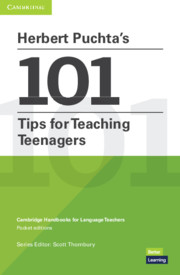 Herbert Puchta's 101 Tips for Teaching Teenagers
Herbert Puchta's 101 Tips for Teaching Teenagers Published online by Cambridge University Press: 28 October 2023
When he was five, he was like most small boys from his home town of Cambridge – he loved to play sports. Then suddenly his life changed when he became very sick with meningitis. Jonnie's parents took him to hospital and he nearly died. The doctors saved his life, but they couldn't save his right leg. He couldn't run around with the other children any more – and he couldn't play football, his favourite sport. In fact, he couldn't do any sports at all.
But the doctors gave him a new, artificial leg. He could walk again, but he wanted to do more than that, so he started dancing and doing other sports. His doctors, his friends and his parents were all surprised that he could do so much. Only 10 months after he lost his leg, he could run, swim and play football again, but running was his best sport.
In 2010, Jonnie started to practise a lot. He wanted to go to the London 2012 Paralympics, the Olympic Games for disabled athletes. Some of the athletes in the Paralympics can't walk, some can't see at all or can't see very well. But in their sports, they can do things that most people can’t.
Jonnie Peacock won gold at the London 2012 Paralympic Games when he was only 19 years old.
To save this book to your Kindle, first ensure [email protected] is added to your Approved Personal Document E-mail List under your Personal Document Settings on the Manage Your Content and Devices page of your Amazon account. Then enter the ‘name’ part of your Kindle email address below. Find out more about saving to your Kindle.
Note you can select to save to either the @free.kindle.com or @kindle.com variations. ‘@free.kindle.com’ emails are free but can only be saved to your device when it is connected to wi-fi. ‘@kindle.com’ emails can be delivered even when you are not connected to wi-fi, but note that service fees apply.
Find out more about the Kindle Personal Document Service.
To save content items to your account, please confirm that you agree to abide by our usage policies. If this is the first time you use this feature, you will be asked to authorise Cambridge Core to connect with your account. Find out more about saving content to Dropbox.
To save content items to your account, please confirm that you agree to abide by our usage policies. If this is the first time you use this feature, you will be asked to authorise Cambridge Core to connect with your account. Find out more about saving content to Google Drive.